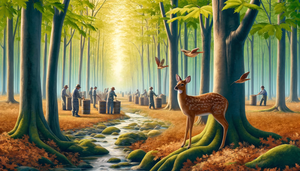Challenges of Wildlife Monitoring in Maple Forests
Jul 08, 2024
Maple syrup production is a cherished tradition deeply rooted in the culture and landscape of places like Vermont. However, the idyllic image of tapping trees and boiling sap conceals the complex challenges of monitoring wildlife populations within these productive maple forests. For those who appreciate the artisanal quality and sustainability of local maple syrup, understanding these challenges adds depth to the sweet pleasure they enjoy.
The Intersection of Production and Wildlife
Maple forests, or sugarbushes, are not just syrup factories but vibrant ecosystems teeming with wildlife. Monitoring the health and numbers of these animal populations is crucial for maintaining biodiversity and ensuring the sustainability of both the forest and syrup production.
Impact of Human Activity
Human activities, such as tree tapping, road building for access, and the presence of workers, can disrupt wildlife habitats. The increased human presence and noise may affect animals like deer, birds, and smaller forest creatures. Here are some specific challenges:
- Habitat Disruption: Continuous movement and noise from tapping activities can disturb nesting birds and mammals.
- Tree Health: Excessive tapping can weaken trees, making them less hospitable for wildlife that relies on them for food and shelter.
- Pollution and Waste: Improper waste management can lead to soil and water contamination, affecting the entire ecosystem.
Seasonal Challenges
The seasonal nature of maple syrup production coincides with critical periods for wildlife. For instance, tapping occurs in late winter to early spring, overlapping with the breeding seasons of many animals. This timing can exacerbate the impact on wildlife populations.
- Winter Stress: Animals already stressed by winter conditions may struggle with the additional disturbance.
- Breeding Interference: Noise and human activity can disrupt mating rituals and nesting.
Technological Limitations
Monitoring wildlife in such environments poses technological challenges. Traditional direct observation and tracking methods can be intrusive and less effective in dense forests.
- Remote Sensing: While helpful, it often lacks the resolution to monitor smaller species or subtle ecological changes.
- Camera Traps: These are helpful but can be limited by battery life, data storage, and the need for regular maintenance.
Ensuring Sustainable Practices
Despite these challenges, there are several strategies that producers and conservationists can employ to balance production and wildlife conservation.
Adaptive Management
Adapting management practices based on ongoing monitoring and research can mitigate negative impacts.
- Selective Tapping: Implementing rotational tapping schedules to prevent over-harvesting of any area.
- Buffer Zones: Creating undisturbed areas within the sugarbush where wildlife can thrive without human interference.
Technological Innovations
Advancements in technology offer new ways to monitor wildlife more effectively and with less disturbance.
- Drones: Can provide aerial surveys of large areas without disturbing the ground-level habitat.
- Bioacoustics: Using sound recording devices to monitor animal activity and presence.
Embracing the Natural Harmony
Understanding the challenges and solutions in wildlife monitoring enhances the appreciation of maple syrup as a product and a result of harmonious interaction with nature. Maple syrup lovers, foodies, and sustainability advocates can take pride knowing that each sweet drop is part of a broader commitment to preserving the environment.
FAQs
Q: How does maple syrup production affect wildlife?
A: Production activities can disrupt habitats, stress animals, and interfere with breeding seasons.
Q: What are some sustainable practices in maple syrup production?
A: Selective tapping, creating buffer zones, and using advanced monitoring technologies like drones and bioacoustics.
Q: Why is wildlife monitoring necessary in maple forests?
A: It ensures the ecosystem's health, maintains biodiversity and supports sustainable syrup production.
Q: What technological advancements help in wildlife monitoring?
A: Drones for aerial surveys and bioacoustics for sound monitoring are among the key innovations.


